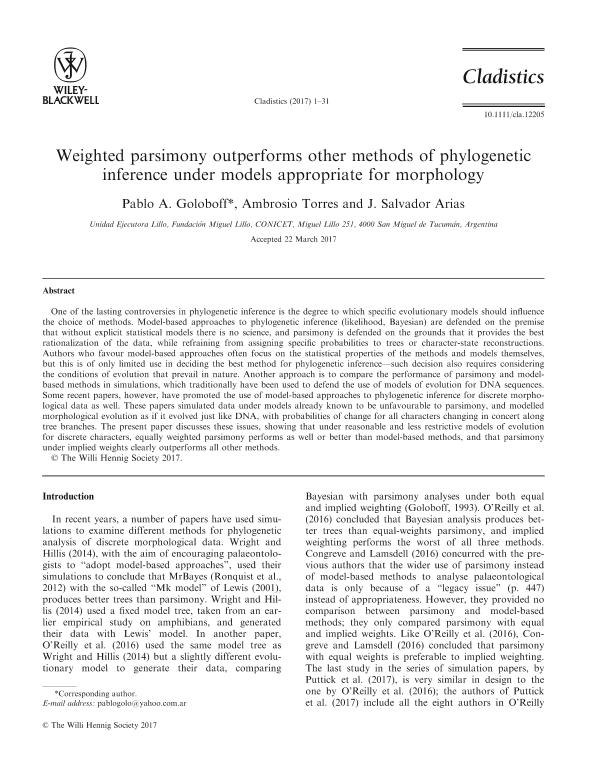Mostrar el registro sencillo del ítem
dc.contributor.author
Goloboff, Pablo Augusto

dc.contributor.author
Torres Galvis, Ambrosio

dc.contributor.author
Arias Becerra, Joan Salvador

dc.date.available
2018-08-30T21:03:47Z
dc.date.issued
2018-08
dc.identifier.citation
Goloboff, Pablo Augusto; Torres Galvis, Ambrosio; Arias Becerra, Joan Salvador; Weighted parsimony outperforms other methods of phylogenetic inference under models appropriate for morphology; Wiley Blackwell Publishing, Inc; Cladistics; 34; 4; 8-2018; 407-437
dc.identifier.issn
0748-3007
dc.identifier.uri
http://hdl.handle.net/11336/57822
dc.description.abstract
One of the lasting controversies in phylogenetic inference is the degree to which specific evolutionary models should influence the choice of methods. Model-based approaches to phylogenetic inference (likelihood, Bayesian) are defended on the premise that without explicit statistical models there is no science, and parsimony is defended on the grounds that it provides the best rationalization of the data, while refraining from assigning specific probabilities to trees or character-state reconstructions. Authors who favour model-based approaches often focus on the statistical properties of the methods and models themselves, but this is of only limited use in deciding the best method for phylogenetic inference—such decision also requires considering the conditions of evolution that prevail in nature. Another approach is to compare the performance of parsimony and model-based methods in simulations, which traditionally have been used to defend the use of models of evolution for DNA sequences. Some recent papers, however, have promoted the use of model-based approaches to phylogenetic inference for discrete morphological data as well. These papers simulated data under models already known to be unfavourable to parsimony, and modelled morphological evolution as if it evolved just like DNA, with probabilities of change for all characters changing in concert along tree branches. The present paper discusses these issues, showing that under reasonable and less restrictive models of evolution for discrete characters, equally weighted parsimony performs as well or better than model-based methods, and that parsimony under implied weights clearly outperforms all other methods.
dc.format
application/pdf
dc.language.iso
eng
dc.publisher
Wiley Blackwell Publishing, Inc

dc.rights
info:eu-repo/semantics/openAccess
dc.rights.uri
https://creativecommons.org/licenses/by-nc-sa/2.5/ar/
dc.subject
Análisis Filogenético
dc.subject
Pesado de Caracteres
dc.subject
Máxima Verosimilitud
dc.subject
Análisis Bayesiano
dc.subject
Datos Morfológicos
dc.subject.classification
Otras Ciencias Biológicas

dc.subject.classification
Ciencias Biológicas

dc.subject.classification
CIENCIAS NATURALES Y EXACTAS

dc.title
Weighted parsimony outperforms other methods of phylogenetic inference under models appropriate for morphology
dc.type
info:eu-repo/semantics/article
dc.type
info:ar-repo/semantics/artículo
dc.type
info:eu-repo/semantics/publishedVersion
dc.date.updated
2018-08-30T13:31:19Z
dc.journal.volume
34
dc.journal.number
4
dc.journal.pagination
407-437
dc.journal.pais
Reino Unido

dc.journal.ciudad
Londres
dc.description.fil
Fil: Goloboff, Pablo Augusto. Consejo Nacional de Investigaciones Científicas y Técnicas. Centro Científico Tecnológico - Tucumán. Unidad Ejecutora Lillo; Argentina
dc.description.fil
Fil: Torres Galvis, Ambrosio. Consejo Nacional de Investigaciones Científicas y Técnicas. Centro Científico Tecnológico - Tucumán. Unidad Ejecutora Lillo; Argentina
dc.description.fil
Fil: Arias Becerra, Joan Salvador. Consejo Nacional de Investigaciones Científicas y Técnicas. Centro Científico Tecnológico - Tucumán. Unidad Ejecutora Lillo; Argentina
dc.journal.title
Cladistics

dc.relation.alternativeid
info:eu-repo/semantics/altIdentifier/doi/http://dx.doi.org/10.1111/cla.12205
dc.relation.alternativeid
info:eu-repo/semantics/altIdentifier/url/https://onlinelibrary.wiley.com/doi/abs/10.1111/cla.12205
Archivos asociados
